- 17 Jun 2024
- 8 Minutes to read
-
PDF
Update Unique Records
- Updated on 17 Jun 2024
- 8 Minutes to read
-
PDF
Overview
Cloudingo enables users to create a customized list of records for bulk updates. This can be accomplished by selecting specific field values, such as updating all records with a company name of "XYZ" or updating all records with a status of "Open" that were created on a particular day. After specifying the desired records, users can perform bulk actions such as updating field values or executing tasks like attaching records to a campaign or creating a note.
Navigation
- Choose the ‘Tools’ → ‘Update’ option from the left-hand-side navigation window.
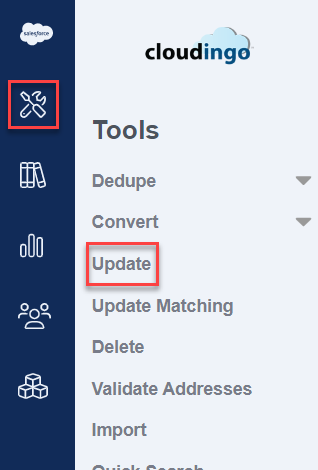
2. Tabs at the top of the page separate the indexed objects. Choose 'All' to view all indexed and non-indexed object filters.
- Choose ‘Create New Job’ to build a new filter.
- Choose ‘Edit’ from a specific filter’s menu option to edit an existing filter.
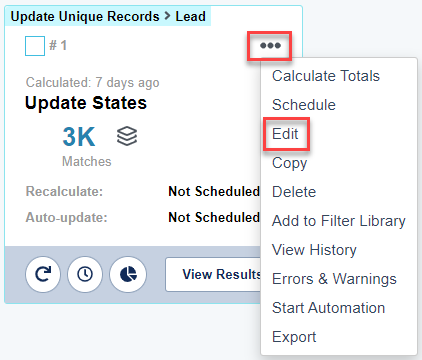
Actions & View Options
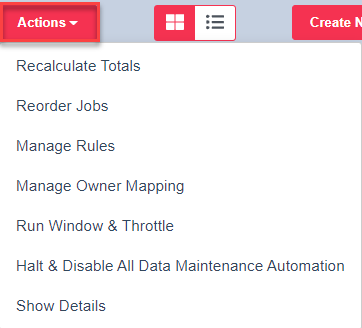
- The 'Actions' menu provides a variety of options.
- Recalculate Totals: Recalculates (queries) all filters at one time.
- Reorder Jobs: Choose this option to reorder the filters for display.
- Manage Rules: Choose this option to get directly into the Manage Rules page.
- Manage Owner Mapping: Choose this option to get directly into the Owner Mapping page.
- Run Window & Throttle: Choose this option to get directly into the Run Window & Throttle page.
- Halt & Disable All Data Maintenance Automation: Choose this option to temporarily stop all currently running or future automation jobs.
- Jobs currently running can take time to completely stop.
- Show Details: Choose this option to show additional filter details (such as the filter description, fields used, and the rule applied if applicable.
- Choose 'Hide Details' from the 'Actions' menu to return back to the regular filter view.
- Choose 'Hide Details' from the 'Actions' menu to return back to the regular filter view.
- Toggle between Tile View or List View to control how filters are displayed.

- Sort By: Choose from a variety of sort options to display filters.
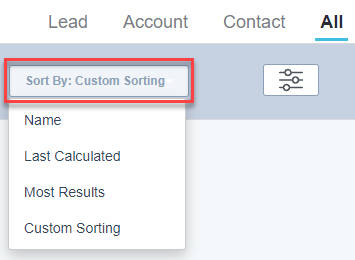
- View Settings: Choose from a variety of view settings to display filters.
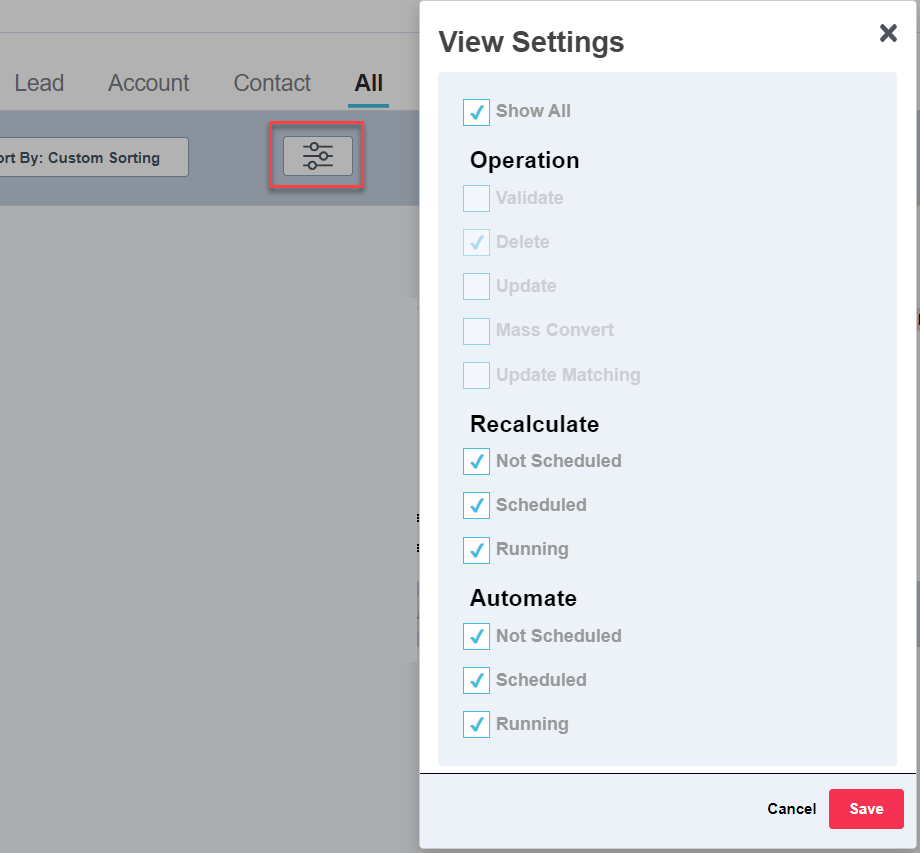
Step 1: The basics
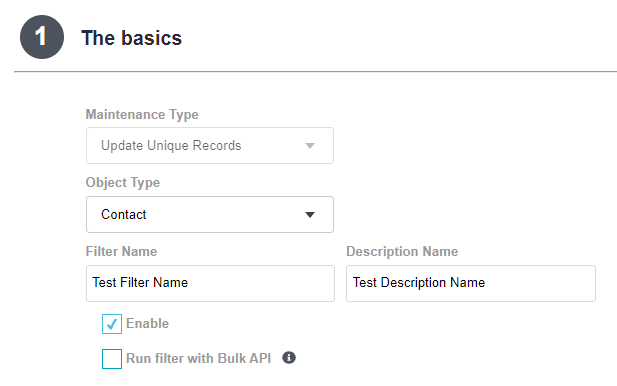
- Maintenance Type: This will automatically default to ‘Update Unique Records’.
- Object Type: Choose the object that the updates will be applied to. The list includes any standard or custom object.
- Filter Name: Give the filter a descriptive name.
- Description Name (optional): Give a brief description of the filter.
- Enable: All filters are enabled by default. Disabling makes the filter inactive.
- Run filter with Bulk API: Choose this option for any indexed objects that should use Bulk API to query for records. Non-indexed objects use Bulk API by default.
Step 2: Which records do you want to update?
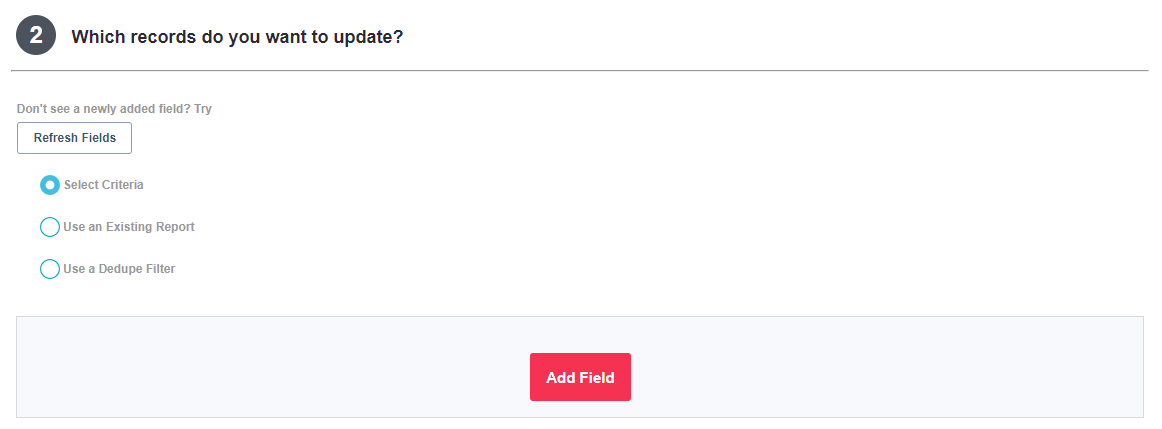
- Select Criteria: Build criteria to filter out records to update.
- Choose the ‘Add Field’ button to begin adding fields to the criteria.
- (Object) Field: Choose a field for the criteria to find records.
- Use the ‘Refresh Fields’ option at the top of Step 2 if a field is not showing in the list.
- Use caution when using formula, calculated, or related object fields. Syncs are not sent to Cloudingo when the underlying value is changed. Reindexing may be required. Consider using a Salesforce report instead of building criteria when using these field types.
- Condition: Choose a condition (such as ‘Equal’, ‘Contains’, ‘Has a value’, etc.).
- Specify a value in the far-right blank box if one appears if applicable. Some conditions do not require a value to be set.
- Or Has No Value: Choose this option to also allow records with a blank value for the field to pull into the results.
- Click ‘Add Field’ again to add additional criteria to find records.
- Use an Existing (Salesforce) Report:
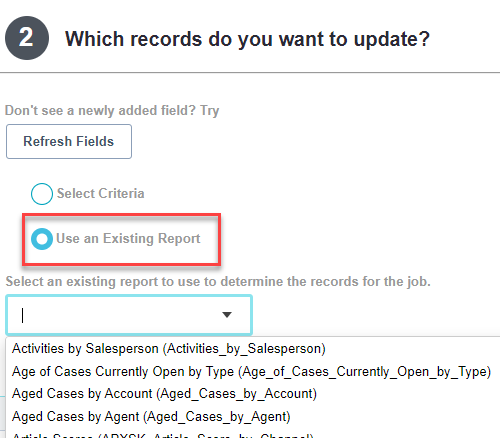
- Salesforce reports will appear in the drop box when this option is selected. Choose the desired Salesforce report to pull the list of records to update.
- Report must contain the Salesforce Record ID using the standard ID field in the output.
- Report must be accessible to the user establishing the Cloudingo connection.
- Salesforce reports will appear in the drop box when this option is selected. Choose the desired Salesforce report to pull the list of records to update.
- Use a Dedupe Filter:
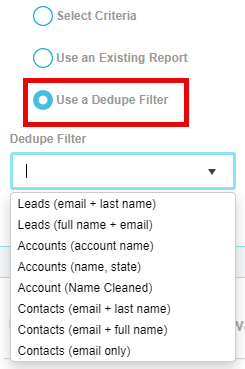
- Pre-configured Dedupe filters will appear in the drop box when this option is selected. Choose the desired Cloudingo Dedupe filter to pull the list of records to update.
- All records (master & non-master) will be pulled into the update filter.
- Filters created using a Dedupe Filter cannot be added to the Filter Library for sharing. Filter Library option will not be visible from the Update Unique filter's menu options.
- Pre-configured Dedupe filters will appear in the drop box when this option is selected. Choose the desired Cloudingo Dedupe filter to pull the list of records to update.
Step 3: What fields do you want to update?
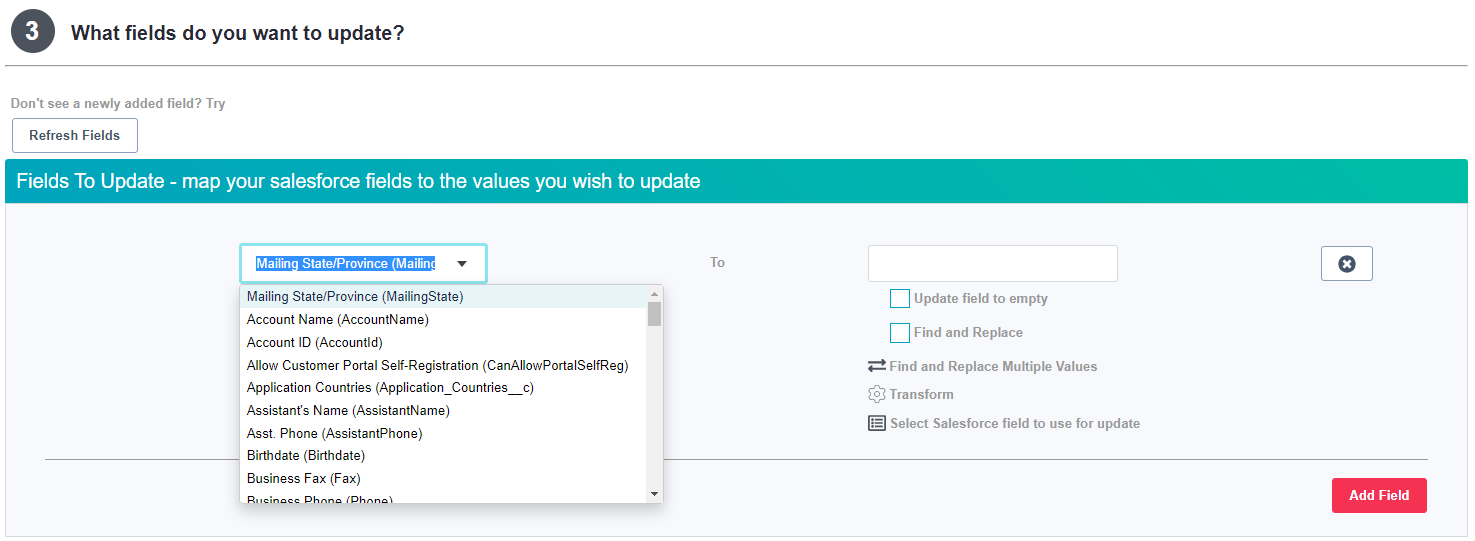
- Click the ‘Add Field’ option to specify a field to update.
- Choose the field in the first drop box.
- Use the ‘Refresh Fields’ option at the top of Step 3 if a field is not showing in the list.
Update Options
1. Update to a specific value
- Sets the value for all records in the filter to a specified value.
- Populate the blank box on the right-hand side with a specific value to get applied.
2. Update field to empty
- Sets the value for all records in the filter to blank.
- Use caution with this, as it will blank out the value for all records in the job.
3. Find and Replace

- Find a specific value and replace all records with a different value.
- Works similar to Excel find & replace.
- Partial values are searched within the field string.
- Type a value in the ‘Find’ box.
- Type a value in the ‘Replace’ box.
4. Find and Replace Multiple Values

- Same as ‘Find and Replace’, but multiple find and replace settings can be configured in one rule.
- Type a value in the ‘Find’ box.
- Type a value in the ‘Replace’ box.
- Click ‘Add’.
- Repeat this process until all find & replace values are configured.
- Click ‘OK’ when finished.
5. Transform
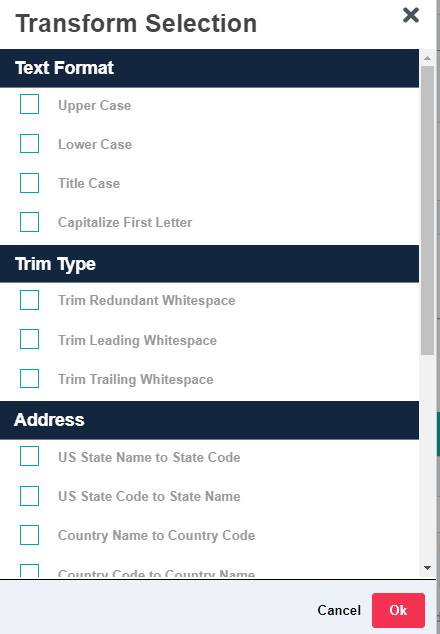
- Text Formatting: Set values to all upper, lower, title case (upper first letter of each word), or capitalize first letter.
- Trim Type: Removes redundant extra spaces from within the string or from the begging or end of a string value.
- Address: Standardize State or Country values from spelled-out version to state/country code or vice versa.
- Phone Format: Standardize phone values to include parentheses, dashes only, spaces, or compacted.
- Extension Format: Standardize extension values to X or Ext prefix and Allow Extension.
- Today: Set to today’s date in a ‘date’ type field value. The date set will be the date the record gets updated.
- Now: Set to the exact date and time (for date/time field types) or time (for time field types). The time set will be the time the record gets updated.
Step 4: What actions do you want to perform? (optional)
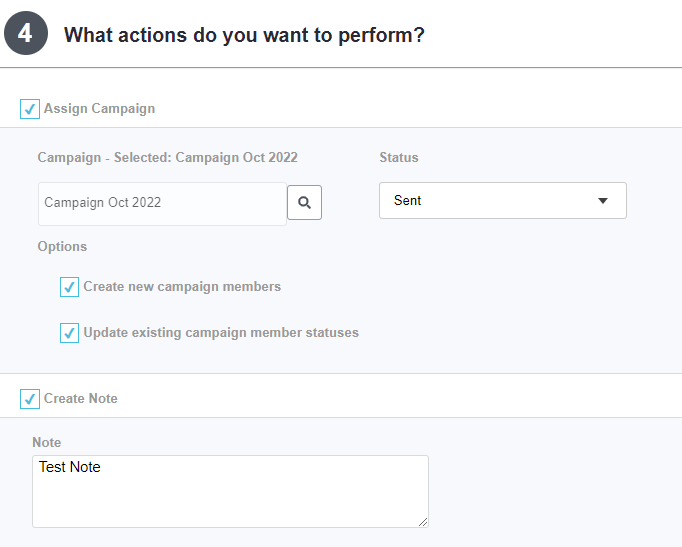
- Assign Campaign: Assign a campaign to all records (Leads or Contacts) in the job while performing the update.
- Choose the ‘Assign Campaign’ option.
- Choose a Campaign in the Campaign box (use search to find a campaign).
- Set a Campaign Status.
- Choose the ‘Create new campaign members’ option to add records in the job to the campaign.
- Choose the ‘Update existing campaign member statuses’ option to update the status of existing campaign members.
- Both options can be enabled simultaneously.
- Convert Lead to Contact: This feature is visible on Lead jobs to accommodate legacy customers with prior configurations. The Mass Convert Leads tool is a newer and easier feature now available to perform updates & conversions simultaneously.
- Convert Lead to Account/Person Account: This feature is visible on Lead jobs to accommodate legacy customers with prior configurations. The Mass Convert Leads tool is a newer and easier feature now available to perform updates & conversions simultaneously.
- Create Note: Creates a note under the 'Notes' or 'Notes & Attachments' section in Salesforce for all records updated.
- Notes are not searchable in Salesforce and take up space.
- Choose ‘Save’ or ‘Save & Run’ (to query for results) to save the filter configuration.
Re-indexing
When creating or editing a filter with new fields (on indexed objects), Cloudingo initiates a re-indexing process on the object that may take time. To avoid this, users can pre-set a list of fields they will be using in their filters by going to 'Account' → 'Settings' → 'Manage Objects' from the top right toolbar.
Preview Results
Make sure to preview the filter results for accuracy before performing updates. Check to ensure that the correct records are pulling in and the correct values will be applied.
- Choose the ‘View Results’ option on the filter after the filter has been calculated.
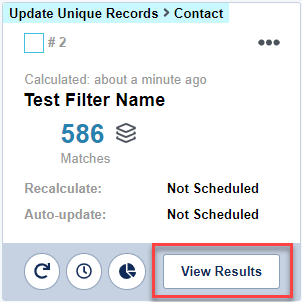
- Choose the red arrow on a group to preview the results. Check a few records for accuracy.
- The preview will display the current record on the left and the values to be updated on the right.

Update
After checking records for accuracy, run the update. There are three ways to update.
- Manually: Update one record at a time from the preview page.

- Update: Updates the record and returns the view back to the record list.
- Update & Load Next: Updates the record and immediately opens the next record.
- Skip & Load Next: Loads the next record without updating the current record.
- Mass Update: Update records one page at a time from the preview page.

- Select records using the checkbox to the left to be updated.
- Or choose the Select All box at the top left corner.
- Choose the ‘Mass Update Unique Records’ button at the top of the record list to submit all selected records in view.
- Page through results using the page numbers at the bottom of the results list.

- Mass Updates can only be done one page at a time.
- Watch the Activity Stream for the update confirmation back from Salesforce to see if updates were successful or a failure (or view the Activity Stream Error/Warnings Report from the Reports dashboard to get a list of failures).
- Results within the pages will refresh in the list as records are updated and when moving through the pages.
- Select records using the checkbox to the left to be updated.
- Automation: Update all records in the filter by starting a one-time automation job or schedule to run the job repeatedly.
- For a one-time job:
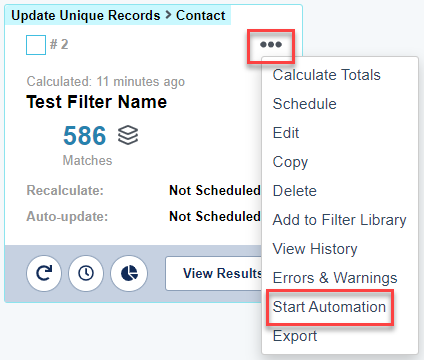
- From the filter’s menu option, choose ‘Start Automation’ or choose the ‘Automation’ menu option from within the preview page and choose ‘Start Automation’.
- Choose ‘Automate’ on the confirmation page.
- Check the 'Run Window & Throttle' settings if the job does not start within a reasonable time.
- Check the 'Run Window & Throttle' settings if the job does not start within a reasonable time.
- To schedule the job to run repeatedly:
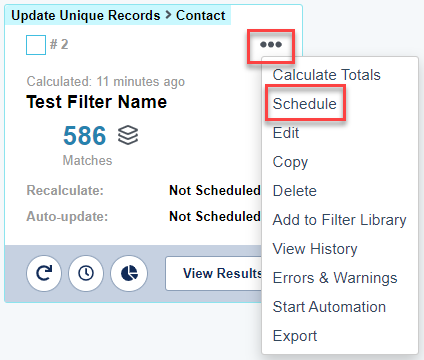
- From the filter’s menu option, choose ‘Schedule’.
- Toggle the dot to the right to enable the ‘Schedule recalculation’.

- Specify a frequency (one time, hourly, daily, or weekly. Set any additional settings related to the frequency as required.
- Specify a start date and start time.
- The ‘Keep Schedule Running’ option must be enabled for the job to continue processing at the scheduled time.
- Toggle the dot to the right to enable ‘Schedule auto – update’ to process the job and ‘Save’. If disabled, the job will only perform the calculation (query) at the scheduled time.
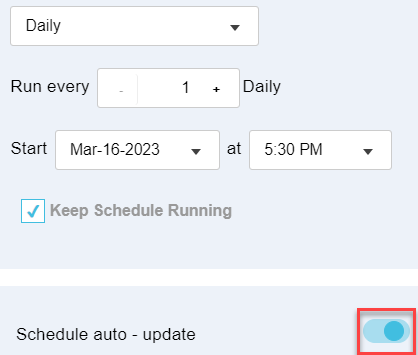
- For a one-time job:
.png)

